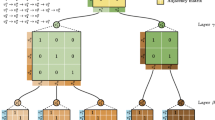Abstract
Networks can be used as a model for the representation and analysis of the physical world. Traditional GIS data models need to be improved if GIS is to be more suitable for network modeling. This paper proposes a feature-based object-oriented data model for transportation networks. It breaks the limitations of the arc-node planar graph model in feature description and topology expression of complicated networks. The basic classes in the data model are explicitly defined. The difference and relationship between physical networks and virtual networks, and the topology representation in virtual networks are discussed. An object-oriented network analysis method is used to construct virtual networks over physical networks in order to make abstract networks more suitable for analysis, and includes a detailed example of a multi-modal traffic network.
Similar content being viewed by others
Reference
W.R. Blunden and J.A. Black. The Landuse/Transportation System. Pergamon: New York, 1984.
F. Bouille. Fuzziness structuring and processing in an object-oriented GIS, URL: http://www.sbg.ac.at/geo/agit/papers94/bouille.htm, 1994.
J. Corbett. Topological principles in cartography, Technical Report, the U.S. Census, 1979.
K. Dueker and J.A. Butler. “GIS-T enterprise data model with suggested implementation choices,” URISA Journal, Vol. 10(1):12–36, 1998.
K.J. Duker and R. Vrana. “Dynamic segmentation revisited: a mile point linear data model”, in: Proceedings of the 1992 geographical information system for transportation symposium, March 2-4, 1992, Portland, Oregon, 63–8, 1992.
D. Fletcher. “Moving toward interoperability,” presented at the TRB 78th annual meeting, Washington, D.C. sponsored by task force on geographic information systems for transportation (GIS-T), also available as URL: http://www.unm.edu/~atr/session479.PDF, 1999.
D. Glenn. “An objective view of segmentation,” in Proceedings of the 1992 geographical information system for transportation symposium, March 2-4, Portland, Oregon, 97–102, 1992.
M.F. Goodchild. “Spatial analysis with GIS: problems and prospects,” in Proceedings of GIS/LIS, Atlanta: ACSM-ASPRS-URISA-AM/FM, Vol. 1:40–8, 1991.
M.F. Goodchild. “Geographical data modeling,” Computers & Geosciences, Vol. 18(4):401–408, 1992.
M.F. Goodchild. “GIS and transportation: status and challenges,” keynote speech, presented at the international workshop on geographic information systems for transportation and intelligent transportation systems, the Chinese University, Hong Kong, 1–12, 1999.
J.R. Herring. “The OpenGIS data model,” Photogrammetric Engineering and Remote Sensing, Vol. 65(5):585–588, 1999.
ISO/TC211, Collection of terms and definitions, Technical Report, 1996.
B. Jourquin and M. Beuthe. “Transportation policy analysis with a geographical information system: the virtual network of freight transportation in Europe,” Transportation Research C: New Technologies, Vol. 4(6):359–371, 1996.
G.J. Koster. “GIS-application development with GeoOOA,” International Journal of Geographical Information Science, Vol. 11(4):307–335, 1997.
Y.C. Lee. “Geographical information system for urban application: problems and solution,” Environmental and Planning B: Planning and Design, Vol. 17:463–473, 1990.
M. Mainguenaud. “Modeling the network component of geographical information systems,” International Journal of Geographical Information Systems, Vol. 9(6):575–594, 1995.
H.J. Miller and J.D. Storm. Geographical information system for network equilibrium-based travel demand models,” Transportation Research C: New Technologies, Vol. 4(6):373–389, 1996.
H.J. Miller. “GIS design for multimodal network analysis,” Proceedings of GIS/LIS, Bethesda: ACSM/ASPRS-AAG-URISA-AM/FM, Vol. 2:750–759, 1995.
O.A. Nielsen, T. Israelsen and E.R. Nielsen. “GIS-based method for establishing the data foundation for traffic models,” in Proceedings of Arc/Info user conference'97, also available at URL: http://www.esri.com/base/ common/userconf/proc97, 1997.
OpenGIS, OpenGIS specifications, URL: http://www.opengis.org/techno/specs.htm, 1998.
D. Peuquet and L. Qian. “An integrated database design for temporal GIS,” Proceedings of the 7th International Symposium on Spatial Data Handling, Delft: Faculty of Geodetic Engineering, Delft University of Technology, 21–31, 1996.
B.A. Ralston. “Object oriented spatial analysis,” in S. Fotheringham, and P. Rogerson, Spatial analysis and GIS. Taylor and Francis: Bristol, 1994:165–186, 1994.
E. Rosch. “Principles of categorization,” in: E. Rosch and B.B. Lloyd (Eds.), Cognition and Categorization, Halstead: New York, NY, 27–48, 1978.
S. Shaw. “GIS for urban travel demand analysis: requirement and alternatives, computing,” The Environment and Urban Systems, Vol. 17:15–29, 1993.
S. Shaw. “GIS challenges in urban transportation planning applications,” in Proceedings of GIS AM/FM Asia'97 and Geo-informatics'97, Taipei, Taiwan, May 26-29, 485–494, 1997.
A.Y. Tang, T.M. Adams, and E.L. Usery. A spatial data model design for feature-based geographical informatiozn systems,” International Journal of Geographical Information Systems, Vol. 10(5):643–659, 1996.
E.L. Usery. “A feature-based geographic information system model,” Photogrammetric Engineering and Remote Sensing, Vol. 62(7):833–838, 1996.
M. Wojnarowska, Y.C. Lee, and B.A. Renault. “A design for handling line collocation,” in Proceedings of the Canadian Conference on GIS, Ottawa, June 6-10, Vol. 2:1681–1690, 1994.
Author information
Authors and Affiliations
Rights and permissions
About this article
Cite this article
Zhou, C., Lu, F. & Wan, Q. A Conceptual Model for a Feature-Based Virtual Network. GeoInformatica 4, 271–286 (2000). https://doi.org/10.1023/A:1009853309757
Issue Date:
DOI: https://doi.org/10.1023/A:1009853309757




